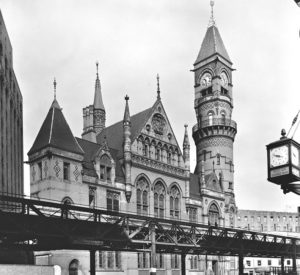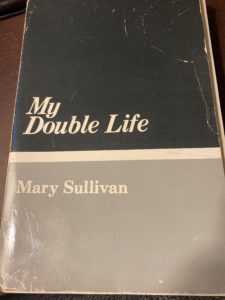On Being a Lesbian in the Early 20th Century; Branded as Deviants, They Were Sometimes Jailed!

Jefferson Market Court in 1935. Photograph by Berenice Abbott (1935). Wikicommons.
The lives of gay men and the indignities they suffered in the late 19th and early 20th centuries has been widely documented — Oscar Wilde made sure of that! All the while, lesbians unobtrusively managed to find love and companionship in spite of the fact that their existence was rarely acknowledged.
In Greenwich Village, tea rooms provided space for women to meet each other away from the disapproving eye of society. On a recent tour of the Village with the Bowery Boys, we were shown one of the basement entrances for a former tea room. In those days it bore a sign that read, “Men are admitted but not welcome.”

Photo by me
Of course, the police knew about these places. In her autobiography, Mary Sullivan, one of the first police matrons to do actual police work, wrote, “A few tearooms run by women with a fondness for college girl patronage really were a menace…”

Photo by me
She added, “One of the most difficult types of degenerate with whom we have to deal is the woman with homosexual tendencies.” The police department received a complaint about “indecent literature” on sale in one of the tea rooms and a proprietess who “tried to entice girl students from a nearby college.” So Sullivan and one of her female colleagues set out to entrap the proprietess.
They visited the tea room, and the other police woman accepted a date from the proprietess, a woman named Billie. After trying to kiss the woman while on their date, Billie was arrested and then convicted of “disorderly conduct and distributing obscene literature.” She was sentenced to six months in the workhouse. Her tea room was closed.
Sullivan didn’t think jailing women with “homosexual tendencies” was the solution, however. “There is no doubt in my mind that they should be treated primarily as medical and psychiatric cases, though we still have must to learn about the method of treatment.” Well, we all know where that eventually led: the horrors of conversion therapy!
Not all lesbians kept quiet or hid their preferences. I’ll talk about the most famous one in my next blog.
Trish, has your research turned up anything about if the situation was similar in other American cities (such as New Orleans, a less WASPish city) or in European cities (Paris?) During the same period? That doesnt dieectly affect your characters’ treatment in NYC, but if they knew that the situation was different elsewhere, that might affect their perspective of their treatment.
I didn’t research other cities. I have the sense that society in New York was fairly progressive but the laws throughout the country were not.